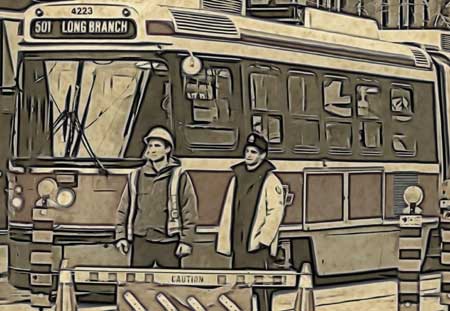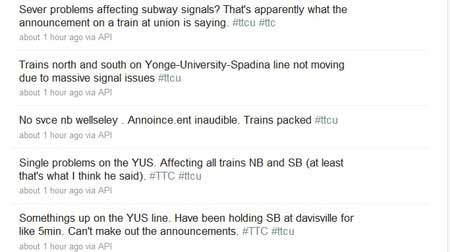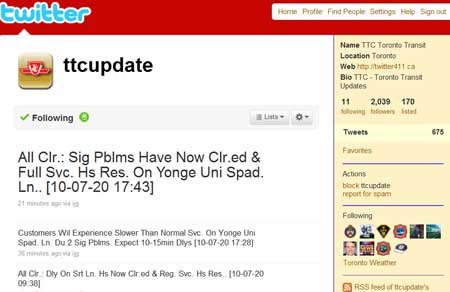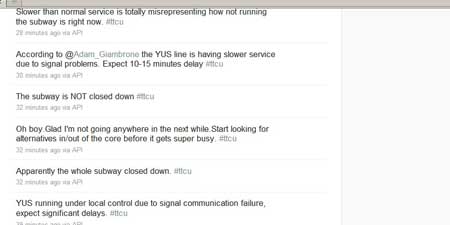
Toronto’s public transit system was once, many years ago, one of the world’s best, boasting of its success with the slogan ”the better way.”
Then came the Mike Harris neo-Conservative provincial government in the 1990s, an ideologically blind bunch who did something that no one, not even in the United States with its aversion in many jurisdictions to public spending, had done, downloading the costs completely to the citizens of then Metropolitan Toronto, leaving inadequate funding for the system.
Since then service has deteriorated. The subway system is plagued with frequent signal failures and service is stopped almost daily as Toronto Fire responds to yet another “smell of smoke at track level.”
So how do the millions of daily transit users find out what is happening on the system? The public address system is so bad, so unintelligible, that it has even spawned satirical commercials — for products such as insurance.
For years, if there was a problem, it was often impossible to find out what as going on. You were stuck on a subway platform with perhaps hundreds of other people, wondering what was happening. Or even worse you’d be waiting in the cold and snow for a streetcar or bus that, it seemed, would never come…
Along came Twitter, and Twitter talks to smart phones. So the Toronto Transit Commission began sending out service alerts from @ttcupdate.
 TTC Communications chief Brad Ross @bradttc, also tweets, including updates on service interruptions (and gets a growing number of service complaints.). But those tweets are few and often late.
TTC Communications chief Brad Ross @bradttc, also tweets, including updates on service interruptions (and gets a growing number of service complaints.). But those tweets are few and often late.
TTC chair, Adam Giambrone, a politician, and the usual on-camera spokesperson for the public transit system also tweets at @Adam_Giambrone including updates of service interruptions. But those tweets are few and often late.
system also tweets at @Adam_Giambrone including updates of service interruptions. But those tweets are few and often late.
If you’re standing on a crowded platform, looking at a subway car stuffed like a sardine, and the public address system sounds like an alien transmission that would take Mr. Data an entire episode of Star Trek: The Next Generation to decode, what are you going to do?
Get off the platform, go upstairs since cell phones don’t work on the subway system and wait for a tweet from #ttcu, the public transit crowd sourcing alert system.
That’s what happened today. I had left the downtown Y after a late workout and was heading home at the start of the rush hour when an overcrowded train pulled in. I was waiting for the next train since I couldn’t get in a car. The train never moved. There was a garbled, low volume announcement. People started getting off the train and heading upstairs. So I followed and as soon as I was near the entrance my aging Treo 700 tweeted. #ttcu was getting updates from stranded passengers all across the system. (For chronological order read from the bottom up. For people outside Toronto YUS stands for Yonge University Spadina subway line)
 It was clear that going home by subway wasn’t an option, so I left that station and headed a few blocks south on Yonge St. to grab a streetcar, my Treo tweeting all the way down. The customers who were able to tweet apparently getting their information from the drivers rather than the public system.
It was clear that going home by subway wasn’t an option, so I left that station and headed a few blocks south on Yonge St. to grab a streetcar, my Treo tweeting all the way down. The customers who were able to tweet apparently getting their information from the drivers rather than the public system.
As I got on the College streetcar, frustrated passengers who had left the subway were asking the driver what was going on. “I don’t know, they’re not telling me,” the driver said.
“According to Twitter, there is a major signal failure on the Yonge line,” I said.
“Good old Twitter,” a woman quipped.
People were calling home, telling loved ones they were taking an alternative route. It was not until I had been on the College streetcar for about 10 minutes, approaching Parliament Street that the I received the first official tweet from the TTC (number two in this grab), at least a full half hour after the first public tweet on #ttcu.

The #ttcu tweets told us more than the official ones, that the transit system had started a system of “local control” to get some service moving with the signal system still down.

And the problems continued even after the TTC (see above) had tweeted an all clear.

So here is an example of crowd sourcing and social media as it works best. Fast accurate, information ahead of anything official, or anything from the media. In fact, a couple of weeks ago, during a major power failure in downtown Toronto, at least two TV stations in their live coverage were quoting #ttcu as a reliable source.
And there’s more to it than that, for a journalist #ttcu can be like the old police scanner when someone reports a streetcar diverted or bus held up due to police activity, it’s time for those people on the desks around the city to pick up the phone and find out if it is just another fender bender or another gangland shooting. (yes #ttcu was first to report a gang shooting a couple of weeks ago, even though the actual tweet was simply because a bus was held up by a street blocked by lots of cop cars).
If you’re waiting for a streetcar that never comes, it is hyper-hyper local news. But it’s certainly news you can use (news that you can use that those million dollar news consultants never dreamed of).
